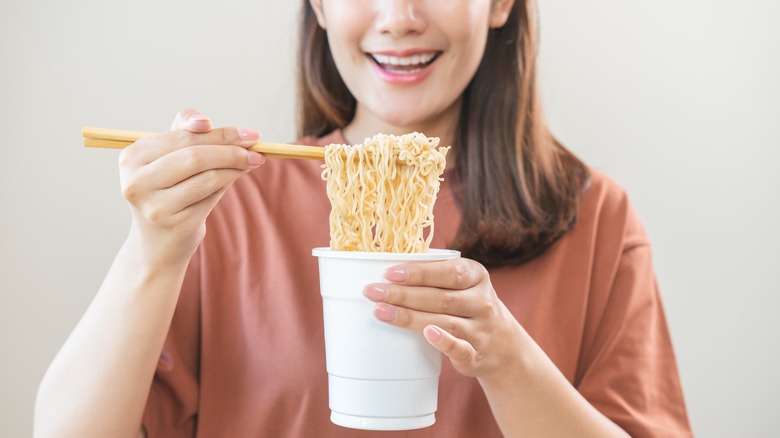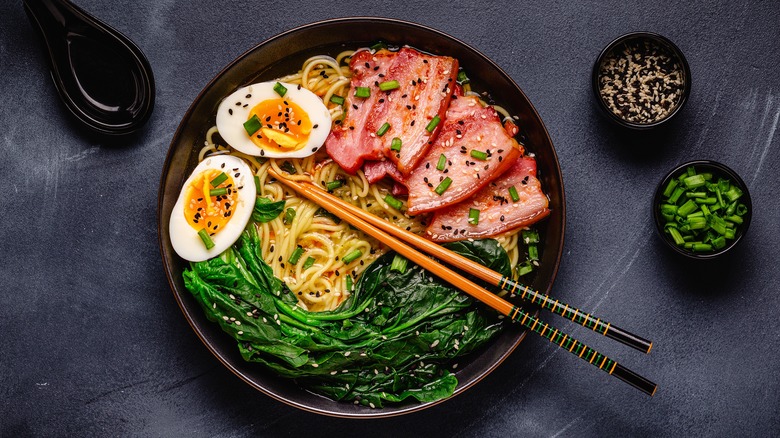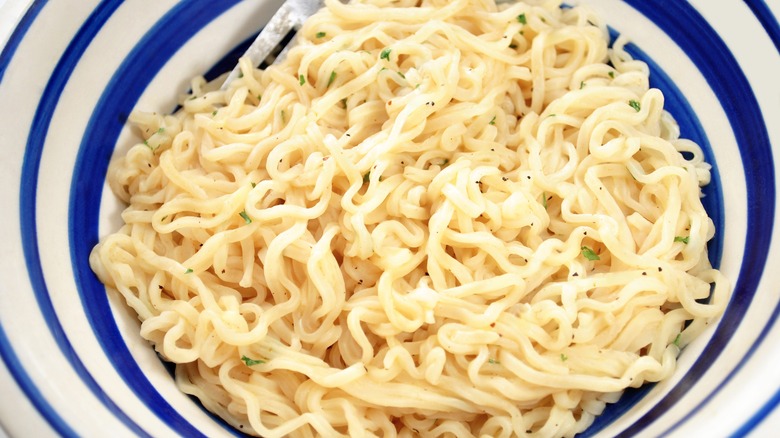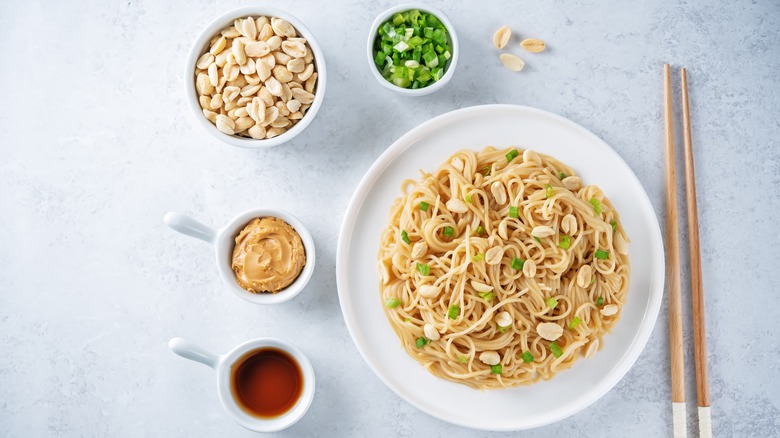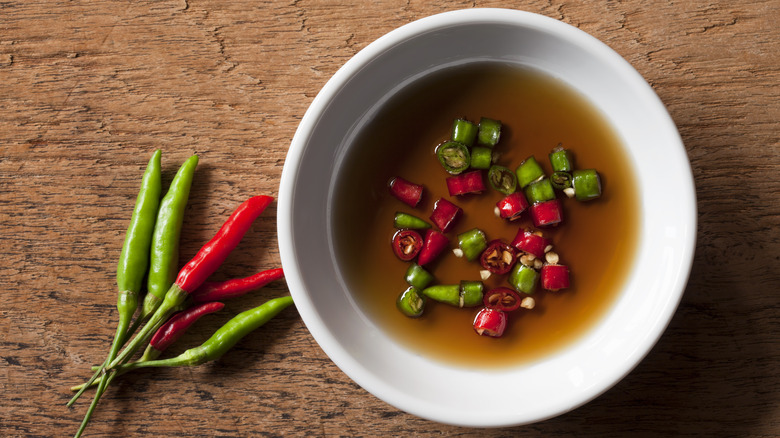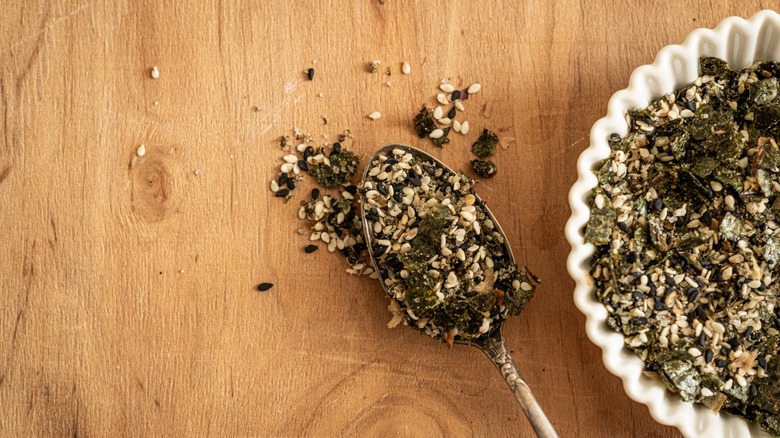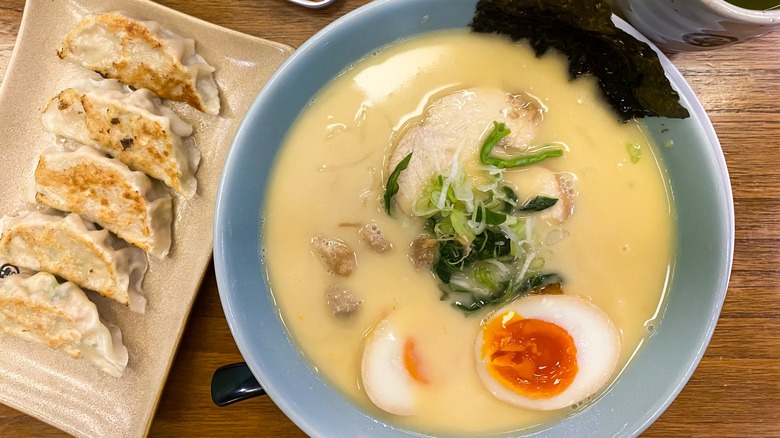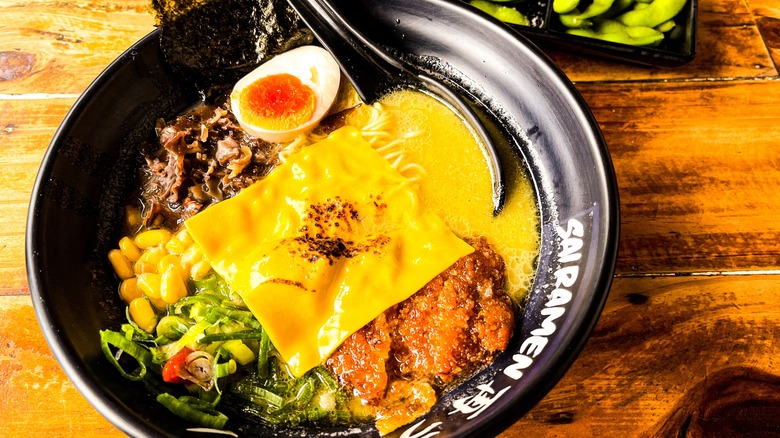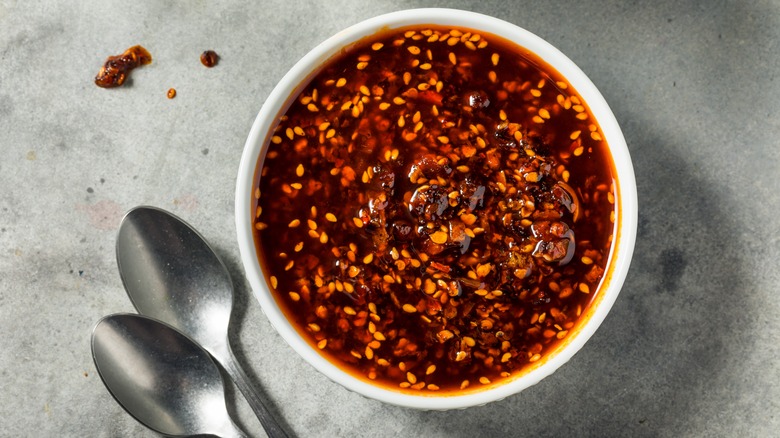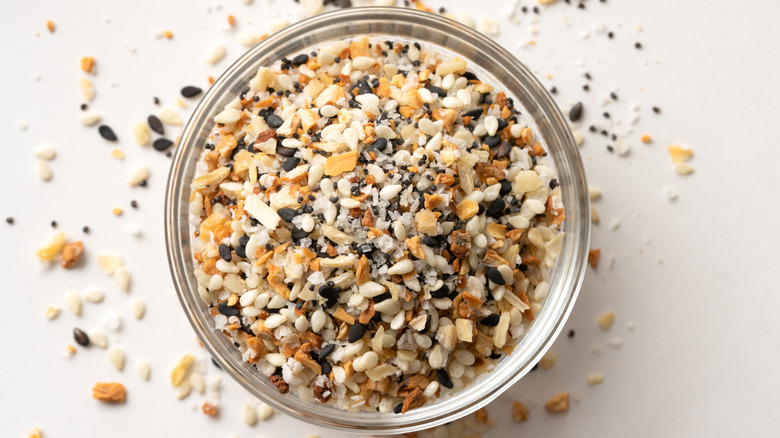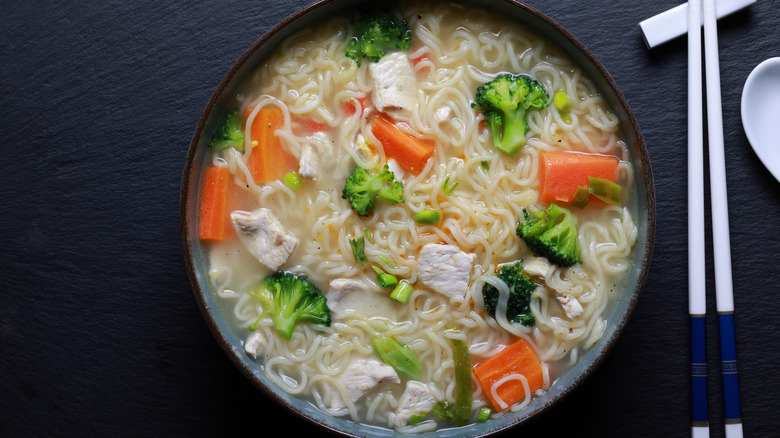Secret Ingredients You Should Be Using In Your Instant Ramen
It's probably not realistic to expect restaurant-level quality noodles when you're brewing up a pot of instant ramen from the comfort of your kitchen. But that's not to say you can't take your meal to the next level and improve it from how it would taste if you were to only use the included seasoning packet. Through the incorporation of just a few added ingredients, it's easier than you think to make your ramen feel like a more worthy and complete dish.
There's tons of freedom when it comes to choosing items to add to your bowl. From ingredients as simple as butter to ones you might not have thought of, such as Spam, the options are endless. They'll elevate your noodles in varying ways, whether it's to reduce spice levels or amp up the nutrition levels. And, of course, each one will make your instant ramen taste all the better, too!
Eggs
Eggs have found their way into most dishes, and ramen is no exception. They're a particularly easy ingredient to incorporate into your noodles since you can go about it in a variety of ways. It's as simple as making them sunny side up and laying them atop the noodles, or scrambling them with all the other contents of your bowl so you get a bite in every forkful.
But one of the most popular methods would be to make "ramen eggs." It's called ajitsuke tamago in Japanese, translating to "marinated eggs" — a pretty straightforward term used to describe soft-boiled eggs soaked in soy sauce and other ingredients like mirin, sugar, and more spices. These eggs are typically cut in half and laid face-up on the ramen, allowing the delightfully runny yolk to drip down and infuse the soup with a creamy, sweet, and salty flavor that pairs well with every type of ramen.
Not to mention, the look of the egg not only elevates your meal's taste, but its aesthetic too. A yellow-orange splash of color in your bowl makes it seem as if much more effort and time went into putting your food together, similar to one that might be served to you at a proper establishment. It's just another reason why jammy, soy marinated eggs are a must for the perfect ramen.
Butter
In 2016, Kylie Jenner shared a picture of her ramen on Snapchat and revealed in the caption that she adds eggs, garlic, and butter to it. Knowing their favorite celebrity eats her noodles with ingredients as simple as those, the public quickly started trying the recipe for themselves. Even now, social media users still eagerly recreate the dish on TikTok to see what makes Jenner eat her ramen the way she does. And as it turns out, the hype is worth it.
You already know why eggs deserve to take up room in your bowl, but how about butter? When the butter melts, it'll add a tasty fat and more depth to your noodles, which is often lacking when it comes to the instant variety. It'll tie in other ingredients that you use, and even help balance spice if you're working with a spicy seasoning packet or adding in your own heat. This is because the extract in chili peppers, called capsaicin, is oil-soluble. It'll dissolve more in butter and lead to lessened spice. Of course, just be careful not to add too much if you're looking to keep the heat level high and avoid greasy noodles.
Peanut butter
Another food high in tasty fat and oil is peanut butter. This means that just like regular old butter, it can similarly be used to offset the heat in your ramen. In addition to neutralizing spice levels, peanut butter also provides a ton of health benefits like protein, vitamin E, fiber, niacin, and more. So even just a bit of this sandwich spread is a good way to add both nutrition and a bold yet familiar flavor to your noodles all at once.
This is something people in Thailand evidently know well. Pad Thai, a classic noodle dish in their country that has also become loved in America, uses ground, toasted peanuts as a garnish. You can imitate the comforting flavor of this Thai staple in a low-effort way by adding as much of the nut butter as you'd like to your instant ramen. You can even supplement it with other commonly used pad Thai ingredients like tamarind paste, bean sprouts, and shrimp to truly seal the deal and make the dish come to life.
Fish sauce
Cooking with fish sauce is a common practice among many cultures, especially in Southeast Asian countries like Vietnam and Thailand. But it's a habit that should really be picked up by everyone, because once you embrace the condiment's potent taste and scent, you'll realize how wonderfully it can transform a dish, just like soy sauce can. The oil-rich fish, salt, and water used to create fish sauce come together in a powerful combination that can enhance meat, seafood, vegetables, and, you guessed it — soups and noodles, too.
Splashing just a bit of fish sauce into your instant ramen will immediately add a unique tang and savory, complex flavor. As expected due to the sauce's name, there's a fishy quality to the condiment, but once heated and combined with other ingredients in your food, you'll be left with a pleasant umami taste instead. It should still be used sparingly, though, as a little of this pungent sauce goes a long way. The sodium content is also on the higher side, which instant ramen surely doesn't need more of. So start off light-handed, and gradually add more as needed.
Furikake
What better way to amp up a traditional Japanese dish than with a traditional Japanese condiment? Originating from the East Asian country just as ramen did, furikake is a dry seasoning composed of a dehydrated, finely ground protein source, such as fish, pork, chicken, or beef. It's seasoned with soy sauce and sugar, and then mixed with sesame seeds and seaweed. Other incorporated ingredients vary depending on the region and recipe the condiment is based upon, but regardless, this seasoning blend is typically used on top of cooked rice or in Japanese rice balls called onigiri to make the carb less bland.
Furikake also tastes delicious when sprinkled into your instant ramen. The result is some light crunch and texture to what might otherwise be an overly soggy dish with mushy, runny ingredients. More importantly, furikake imparts a salty, nutty flavor that without a doubt works well with other ingredients likely already in your bowl. Soy sauce, garlic, ginger, and fresh herbs are just a few of the popular ramen components that your furikake is sure to enhance.
Miso paste
There are more clever ways to use a ramen seasoning packet than you might think, and surprisingly enough, dumping it on your noodles isn't necessarily one of them. That's not to say those pre-packaged mixes aren't sufficient in adding flavor to your bowl. But with them consisting of mostly dehydrated herbs, there are simply other options for making your meal taste a bit more vibrant.
Try swapping your seasoning packet for miso paste instead. Miso is a fermented soybean paste that's commonly consumed in the form of soup. It's often served as an appetizer at Japanese restaurants. Morito Ohmiya, the owner of a noodle and dumpling eatery in Japan called Aji no Sanpei, is widely believed to have been the first person to use miso broth as a base for ramen in 1958.
Now you can quickly make your own miso ramen right at home. Just stop by a local Asian grocery store to pick up a tub of the paste; then read the label's instructions and add the specified amount to your noodle water. As a general rule of thumb, you can employ a 1:1 ratio, and use one tablespoon of miso for every cup of liquid. It's that easy to get a toasty, hearty base for your ramen.
Milk
Spicy instant ramen noodles have been all the rage on TikTok for quite some time now. As users create videos of themselves eating the Korean noodle brand, Samyang Ramen, the company's Buldak line of instant ramen has gone viral. People show off how they like to make their stew, and just as crucial as the noodles are themselves, it seems milk has become equally important in the recipe to counteract the intense, overpowering spice the brand has become recognized for. The dairy not only helps reduce heat, but also makes the whole dish much thicker and creamier.
This ingredient isn't just for spicy ramen, though. You can add coconut milk or soy milk to your instant noodles to make coconut curry ramen or soy milk ramen. The water-to-milk ratio you use ultimately depends on how milky you want your broth to taste, but it's usually more advisable to use a lesser amount of milk. Just pour some into your soup base before eating, and heat it thoroughly. Experimenting with varying types of milk and how much to add can propel you to make your own version of other creamy classics like tomato pasta, Fettuccine Alfredo, or even mac and cheese. Alternatively, heavy cream can be used in certain recipes to achieve similar results, too.
Cheese
Along with milk and other dairy products, cheese can be used to offset spice plus make your noodles thicker and creamier, too. It's the star ingredient of cacio e pepe for a reason! Cheese will melt seamlessly in with your noodles and other ingredients, creating a richer and more filling experience. And it's a tasty, uncomplicated way to get some delectable fat and more carbohydrates into an already savory meal.
You can use whatever variety you would like to achieve this, whether it be parmesan, cheddar, mozzarella, or provolone. Choose between shredded and sliced forms depending on how you want to incorporate the cheese. Roy Choi, an award-winning chef known for creating Kogi, a Korean-Mexican taco truck, demonstrated in a video with Tasting Table how he plops two slices of American cheese atop his already cooked, steaming noodles for an especially trouble-free way to add cheese to his ramen. He goes in with more garnishes like scallions and sesame seeds, then mixes them all up before digging in. If you'd like to take a different route, you can also drain your noodles of the water once they're done cooking, then sprinkle and mix shredded cheese into your ramen. You'll know it's ready when the cheese melts and takes on a delightfully stringy texture.
Chili oil
Putting chili oil into dishes for a dually sweet and spicy taste is nothing new, so it was no surprise when using the condiment as the main ingredient in ramen went viral a few years ago. Though your noodles are instant, the chili oil you're coating them in can be made from scratch. Combine ingredients like vinegar, sesame seeds, garlic, and oil to make it. You can also purchase a premade version from nearby grocery stores, such as Target or Walmart, that will usually have a pretty tame spice level, though some might contain extra hot peppers. Just toss your noodles in a generous amount of your preferred oil to infuse them with a warm, zesty flavor that pleasantly lingers on your tastebuds.
As described, this can be used as the sole flavoring of your noodles. But if you're choosing to make use of that included seasoning packet, chili oil will still work great with any instant ramen type out there. Only the intentionally spicy kinds might not benefit from additional chili, as they contain lots of heat all on their own.
Everything bagel seasoning
Instant ramen didn't get its name for nothing. These convenient noodles are loved because they provide a filling meal that's ready to eat in a very short amount of time. Some people can't afford the extra few minutes needed in the kitchen to enhance their ramen, even if that means adding an egg or sifting through varied herbs to incorporate. Luckily, there's a way for on-the-go busy bees to make their noodles much better without any hassle or effort at all.
The solution? Everything bagel seasoning. This all-in-one product contains salt, onion, garlic, sesame seeds, and poppy seeds. That already covers a bunch of the basic ingredients you likely would've thought to put in your bowl. All the seasonings put into one bottle cut down the time you otherwise would've spent looking for each individual herb in your collection. With the essentials already together in a container, it'll take you less than a minute to top off your ramen for some immediate flavor.
Spam
You either love Spam or you hate it. But if you're a ramen eater who falls into the latter category, we implore you to reconsider. That's because one of the ways to take Spam to the next level is by adding slices of this versatile, canned luncheon meat to your instant noodles. It's an easy-to-prepare ingredient that's already cooked, so all you have to do is cut it up and heat it over a skillet for a few minutes before use.
Made with ground pork and ham, Spam has 12.5 grams of protein per serving of the classic variety. It also contains a small amount of a few key micronutrients, including zinc, copper, potassium, and iron. You can choose from a variety of flavors to spice your bowl up. Depending on what type of ramen you're eating, you're sure to find a variety that pairs well, from Bacon and Korean BBQ to Hot & Spicy and Hickory Smoke. There's even a "lite" version that has significantly less fat, sodium, and calories.
And to further prove the point of why Spam is superior: It's comparable to chả lụa, a Vietnamese pork sausage commonly used in pho noodle soup. The two ingredients have the same meaty, soft yet firm texture that's along the same lines as bologna. So, if Spam bears any resemblance to something as essential to a bowl of pho as chả lụa, why not give it a chance with your instant ramen?
Leftovers
Similar to rice, ramen is like a blank canvas that pairs well with an assortment of ingredients. You can't really go wrong with any foods you choose to throw in; almost anything is fair game. That means having it for dinner is a great opportunity to use up any leftovers you have sitting in your fridge, whether that be shredded pieces of last night's basic roasted turkey or chunks of your soy marinated baked chicken thighs.
Aside from just turkey and chicken, basically any cut of meat, such as pork, beef, and even seafood, will be a delicious addition to your instant ramen. Not only will using your leftovers stop you from wasting perfectly good food, but the sauces and seasonings already on your protein will infuse your soup with more flavor. You can also pick out your aging vegetables and chuck them into your recipe, too. Carrots, bok choy, bean sprouts, and scallions are just a few examples of veggies that can be saved from going bad when added to ramen.
